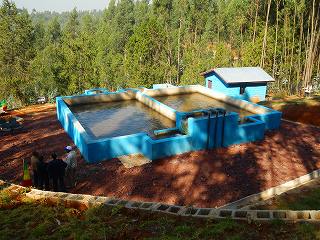| |
 |
An Inauguration ceremony for a project to improve water quality in Gojan Ber Reservoir in Gulele Sub-City, Addis Ababa, took place on 19 November, 2011. The project was funded by the Japanese government through its Grant in-aid-scheme for Grassroots Human Security Projects (GGP) amounting to USD 96,498. It was implemented by the Addis Ababa Water and Sewerage Authority (AAWSA). Mr. Hajime Kitaoka, Minister of the Embassy of Japan in Ethiopia, celebrated the completion of the project, together with Ato Asegid Tesfaye, General Manager of the Addis Ababa Water and Sewerage Authority, local government representatives of the Gulele Sub-City, as well as members of the community.
The water coverage in Addis Ababa is the highest in Ethiopia. However, the quality of water has emerged as a new health problem. In particular, the water supplied from Gojan Ber Reservoir in Gulele Sub-City contains 0.5mg/l of iron which is higher than the recommended limit of 0.3 mg/l. Iron is found in surface and ground water at varying concentration levels. Even at low concentrations, it can be linked to the following problems: discoloration, turbidity, taste problems or the formation of slime and iron oxide accumulations in pipes. It also promotes the growth of certain types of chlorine tolerant micro-organisms in water distribution systems. These problems, along with the frequent complaints from the residents, have challenged AAWSA to come up with a solution.
Mr. Hideo Takita, a Japan International Cooperation Agency (JICA) Volunteer who was assigned to AAWSA, came up with the idea of applying a Japanese Traditional technique called the “Iron Bacterial Method”. This method, which was designed in Japan in the late 1950s, removes iron from ground water by using the iron bacteria that live in the ground water. Iron bacteria are a natural part of the environment in most parts of the world, and they have the ability to absorb soluble iron/manganese, making it insoluble. By harnessing this process and channeling the water through filter sand, the layer of iron bacteria, with the insoluble iron and manganese attached, is removed. Water quality is improved by a series of these actions, and aeration before pouring the water into the filter reservoir also promotes the above action. This method is a simple, economical, effective and sustainable method of removing iron and manganese from water without using electric power and chemicals. Three months after the completion of the plant, the iron level in the Gojan Ber Reservoir is around 0.17mg/l, lower than an initial level of 0.5 mg/l and even the recommended level of 0.3 mg/l.
Mr. Hajime Kitaoka in his speech at the inauguration ceremony expressed his profound gratitude to the Addis Ababa Water and Sewerage Authority as well as JICA Volunteers for their deep devotion to the completion of the project. He said he is most gratified to learn that traditional Japanese knowledge and techniques have improved the water quality, and now 70,000 residents in Gulele Sub-City have access to clean and safe water. He also mentioned that this approach can be replicated in other parts of Ethiopia since the problem of iron and manganese is severe in all nine Regions of Ethiopia.
The Gojan Ber Reservoir in Gulele Sub-City is open to the public. Interested persons may get in contact with the Addis Ababa Water and Sewerage Authority for further information.
|
|



